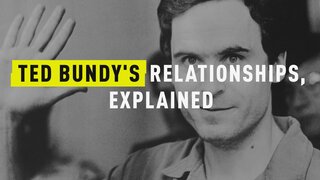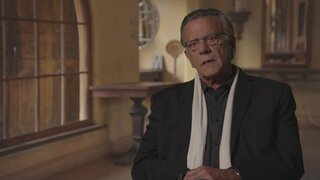Create a free profile to get unlimited access to exclusive videos, breaking news, sweepstakes, and more!
‘You Know What? I Am Going To Kill You’: Suspected Ted Bundy Victim Recounts Her Harrowing Escape
Rhonda Stapley was a pharmacy student at the University of Utah in 1974 when she accepted a ride from a man named Ted — but instead of a ride back to campus, Stapley would find herself in a fight for her life.
Rhonda Stapley was a pharmacy student at the University of Utah in October 1974 when she says she accepted a ride from a stranger named Ted that ended in a horrific attack.
She’s likely one of just a few women targeted by notorious serial killer Ted Bundy who survived the encounter and lived to tell her harrowing tale decades later.
Stapley — who recounts her terrifying brush with a man she believes was Bundy in the new REELZ docuseries “Ted Bundy: The Survivors” — said she had been waiting for the bus on Oct. 11, 1974 after having dental surgery when a young man driving a tan Volkswagen pulled up and offered her a ride back to the campus.
“This didn’t feel like hitchhiking, what I did,” Stapley recalled in the docuseries. “This felt like a friendly college student helping another college student and that seemed normal and not out of place.”
The man told her his name was Ted and he was a first-year law student. The pair soon eased into friendly and “lighthearted” banter as they headed toward the university.
“He looked like a college student,” Stapley said in a 2016 appearance on “Dr. Phil.” “He was dressed nice. He had a green pullover sweater on, nice slacks.”
But even as Stapley and the man exchanged pleasantries, there was one troubling clue about his true intentions on the fateful ride.
“The first thing that I noticed was that the inside passenger door handle was missing and he leaned over and pulled the door shut, but I wasn’t alarmed,” she recalled on Dr. Phil. “I figured college kid, college car, things fall off.”
Stapley also wasn’t overly concerned when he didn’t take the usual road back toward the university, but she did question him about the detour.
“He was very polite, he says, ‘Oh, I hope you don’t mind, I have a short errand to run up by the zoo,’ and I didn’t mind,” she said in the docuseries. “I was with this cute law student. The zoo is just one canyon over from the college and I figured I’d still be home faster than if I’d waited for the bus.”
When he drove past the zoo, Stapley said she questioned him again, jokingly saying, “I thought you were taking me to the zoo.”
The man allegedly responded that he had said the errand was “near the zoo” and when he pulled the car over and backed into an isolated grove of trees, Stapley initially thought he had romance on his mind. However, she was very wrong.
“He turns in his seat so he’s almost facing me in the car and leans in really close, then very, very quietly, he says, ‘You know what? I am going to kill you,’” Stapley, who later penned the book, “I Survived Ted Bundy: The Attack, Escape & PTSD That Changed My Life," recalled in the docuseries.
She said Bundy put his hands on her throat and started to strangle her.
“We had a small battle in the car, but I went unconscious,” she told Dr. Phil. “I thought I was going to die right there in the car, but he had other plans.”
Stapley said she endured three hours of horrific violence as the man raped her and repeatedly strangled her until she was unconscious, she said. Then he revived her and did it again.
“He was standing over me, just slapping my face, just slapping my cheeks back and forth like you see them do when they are trying to wake somebody up and as soon as I am kind of conscious, he grabbed me and started slugging me,” she said in the REELZ docuseries. “He was angry, more angry than I’ve ever seen anybody. His fists were clenched and his veins were bulging on his forehead and his neck, his face was bright red and he was leaning over me and I’m of course sitting there crying and begging for my life. He says, ‘You don’t have the right to cry and whine at me. You should be thanking me that you are even still alive. I can kill you any time I want. You should be thankful that you’re even still breathing air.’”
Stapley got the break she needed when Bundy, who thought she was dead, was distracted by something near his car and she was able to run into the woods.
“As soon as I jumped up and started to run I realized that my pants were in a wad around my ankles and so I tripped just one or two steps and I was falling, but I fell into a fast-moving mountain stream, which swept me away from my attacker and is probably what saved my life,” she said.
Stapley got out of the stream and walked through the woods 10 miles back to her home, too terrified to return to the road in case Bundy had come to look for her.
“I was angry because it was cold and I was wet and cold and freezing,” she recalled in the docuseries. “It was so far to walk.”
When she got home, she discovered her roommates were gone. She got herself cleaned up and vowed that no one would ever know about the horrifying ordeal.
“I imagined people whispering, ‘That’s the girl who was raped,’” she told PEOPLE in 2016 of her decision to stay quiet.
Stapley said she also felt guilty for accepting the ride and believed her mother might take her out of school if she ever found out.
“I felt ashamed and embarrassed and stupid for even getting into such a dangerous situation,” she said in the docuseries. “Everyone knows you are not supposed to take rides with strangers, and people will think, ‘Why did you do that?’”
Stapley was also terrified about the religious implications of coming forward with her story. At the time of the attack, she had been a young Mormon virgin and was worried how she would be viewed by those in the religion if the rape came to light.
“The teachings in the LDS church at that time, the teaching was that your virtue and your chastity are the most important things that a young woman can have, and if you come to a point where there’s a choice of giving up your chastity or your life, you’re probably better off eternally if you die,” she said. “And I hadn’t died, and so I had that kind of guilt too about how do I justify that with God and now I am not pure and I am not chaste anymore and I am not worthy of a nice young man anymore.”
Stapley would see the face of her attacker again about a year later during a local television news report about a man arrested for the attempted kidnapping of Carol DaRonch.
The arrest brought her “another wave of guilt” as she realized that she had not been Bundy’s only victim.
“It was another proof that it was him. ‘That’s the guy.' Maybe I should have done something about it,” she told PEOPLE.
Stapley waited nearly four decades to tell her story, so her account cannot be confirmed by law enforcement; however, crime writer Ann Rule wrote in the forward of Stapley’s book that her “story checks out.”
Rule launched her own career as a true crime author with the book “The Stranger Beside Me,” which depicted the time she worked alongside Bundy at a Seattle crisis clinic.
“Rhonda Stapley, unlike most of the women who have contacted me about their brushes with Bundy, did not suddenly remember her encounter years after it occurred,” Rule wrote in the forward of Stapley’s book. “She didn’t have to try to remember, because she had never forgotten. Ted told her his first name, and she had long, terrifying moments to study his face.”
Rule added that the account is also consistent with the FBI’s timeline of Bundy’s activities in 1974 and said those who knew Stapley “vouch for her honesty.”
“Not only is she a credible witness, but her story checks out,” Rule wrote.
In the years after the harrowing ordeal, Stapley got married, became a mother, and embarked on a career as a pharmacist.
“I thought that I just needed to put it away and make life like it was before and just pretend it never happened,” the now-grandmother told PEOPLE.
After decades of pushing the experience away from her mind, Stapley said her feelings about the attack came to the surface again in 2011 while she was dealing with a bullying incident at work.
“I couldn’t control my tears, I couldn’t sleep, I couldn’t eat,” she said. “I thought I was going crazy. But I knew it had to be related to the Bundy stuff, because that’s what my dreams and my nightmares and my panic attacks were about.”
She eventually decided to speak out about the gruesome attack as a way to process her ordeal.
“I think my experience with Ted Bundy affected every aspect of my life. It changed my level of self-confidence, it changed my trust, even my trust in myself. I became more introverted, less outgoing,” she said in the docuseries.
By sharing her story, Stapley hopes she is able to help other victims of abuse.
“The main thing I wanted to tell people was that they’re not alone,” she told PEOPLE in 2016. “Even though their traumatic experience may be different than my traumatic experience, at least there’s someone who can recognize those feelings and people who can understand.”
The second part of "Ted Bundy: The Survivors" will air on REELZ on Saturday at 8 p.m. ET/5 p.m. PT.
































